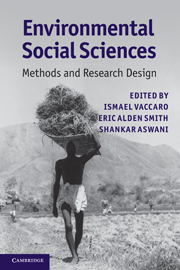Book contents
- Frontmatter
- Contents
- Contributors
- Foreword
- Preface
- 1 Introduction
- 2 People, numbers, and natural resources: demography in environmental research
- 3 Production decisions and time allocation: a guide to data collection
- 4 Analyzing the politics of natural resources: from theories of property rights to institutional analysis and beyond
- 5 Extreme events, tipping points, and vulnerability: methods in the political economy of environment
- 6 Local communities and natural resources: ethnobiology in practice
- 7 Mapping histories: cultural landscapes and walkabout methods
- 8 Metaphors and myths in news reports of an Amazonian “Lost Tribe”: society, environment and literary analysis
- 9 Water decision-makers in a desert city: text analysis and environmental social science
- 10 Linking human and natural systems: social networks, environment, and ecology
- 11 Khat commodity chains in Madagascar: multi-sited ethnography at multiple scales
- 12 Spatiotemporal methodologies in environmental anthropology: geographic information systems, remote sensing, landscape changes, and local knowledge
- 13 Deep time, diachronic change, and the integration of multi-scalar data: archaeological methods for exploring human–environment dynamics
- 14 Comparing trajectories of climate, class, and production: an historical ecology of American yeomen
- 15 Socioecological methods for designing marine conservation programs: a Solomon Islands example
- Index
- References
12 - Spatiotemporal methodologies in environmental anthropology: geographic information systems, remote sensing, landscape changes, and local knowledge
Published online by Cambridge University Press: 05 June 2012
- Frontmatter
- Contents
- Contributors
- Foreword
- Preface
- 1 Introduction
- 2 People, numbers, and natural resources: demography in environmental research
- 3 Production decisions and time allocation: a guide to data collection
- 4 Analyzing the politics of natural resources: from theories of property rights to institutional analysis and beyond
- 5 Extreme events, tipping points, and vulnerability: methods in the political economy of environment
- 6 Local communities and natural resources: ethnobiology in practice
- 7 Mapping histories: cultural landscapes and walkabout methods
- 8 Metaphors and myths in news reports of an Amazonian “Lost Tribe”: society, environment and literary analysis
- 9 Water decision-makers in a desert city: text analysis and environmental social science
- 10 Linking human and natural systems: social networks, environment, and ecology
- 11 Khat commodity chains in Madagascar: multi-sited ethnography at multiple scales
- 12 Spatiotemporal methodologies in environmental anthropology: geographic information systems, remote sensing, landscape changes, and local knowledge
- 13 Deep time, diachronic change, and the integration of multi-scalar data: archaeological methods for exploring human–environment dynamics
- 14 Comparing trajectories of climate, class, and production: an historical ecology of American yeomen
- 15 Socioecological methods for designing marine conservation programs: a Solomon Islands example
- Index
- References
Summary
Introduction
Spatial tools such as remote sensing (RS) and geographic information systems (GIS) are increasingly used in a variety of research and public applications. The popularization of geospatial data and tools in the media and society has significantly changed the way we perceive, understand and manage our landscapes. A variety of social actors have become familiar with these technologies, whether they be an extractivist cooperative disputing borders in the Brazilian Amazon, a US resident checking his property on a cadastral map, or a school teacher in India, using a satellite image to teach regional geography. Today, geospatial technologies are recognized as valuable assets of civil society and essential tools to address social and environmental problems (NAS 2002). The proliferation of satellite and public-domain spatial data, Global Positioning Systems (GPS), affordable computer hardware and software, and data processing and analytical techniques continue to expand the use of these technologies in anthropology generally, and environmental anthropology in particular. Such spatial information is frequently used in visualization (e.g., displays of aerial photography or satellite imagery for a study region) using Google Earth or other public domain software that allow quick online data access/display without requiring specialized training. More in-depth research and analyses entail the use of designated RS/GIS software programs (e.g., ERDAS Imagine, ArcGIS, Idrisi, Multispec, among many others), and the actual acquisition of the relevant GIS datasets (as opposed to merely accessing them for online displays and/or simple queries).
This chapter reviews uses and issues in the application of RS and GIS in anthropological research. We briefly present fundamental geospatial concepts and provide a concise history of RS and GIS applications in anthropology. Next, we review the range of geospatial concerns in anthropological research design, highlighting research questions, units of analysis, data search and temporal sampling, and assessments of data processing needs and analysis. In order to illustrate these geospatial concerns, we focus in particular on land use/cover change research, and provide guidelines for data planning and research design. Finally, we present critical ethical and pragmatic issues in the (re)presentation of spatiotemporal data and maps, reflecting on the positive potential as well as perils of using these tools in anthropological research.
- Type
- Chapter
- Information
- Environmental Social SciencesMethods and Research Design, pp. 266 - 298Publisher: Cambridge University PressPrint publication year: 2010
References
- 2
- Cited by

